Development of an Informative Lithium-Ion Battery Datasheet
Abstract
:1. Introduction
2. Physical Parameters
3. Electrical Performance and Operating Limits
3.1. Capacity Parameters
3.2. Charge/Discharge Procedures and Limitations
3.3. Voltage Parameters
3.4. Impedance/Resistance Parameters
3.5. Energy and Power Parameters
4. Reliability and Recommendations for Storage
4.1. Cycle Life
4.2. Storage Life
5. Safety and Safety Caution
6. Discrepancies in Datasheets for the Same Battery Model
7. Conclusions
Author Contributions
Funding
Institutional Review Board Statement
Informed Consent Statement
Data Availability Statement
Acknowledgments
Conflicts of Interest
References
- Saxena, S.; Roman, D.; Robu, V.; Flynn, D.; Pecht, M. Battery stress factor ranking for accelerated degradation test planning using machine learning. Energies 2021, 14, 723. [Google Scholar] [CrossRef]
- Diao, W.; Saxena, S.; Han, B.; Pecht, M. Algorithm to determine the knee point on capacity fade curves of lithium-ion cells. Energies 2019, 12, 2910. [Google Scholar] [CrossRef] [Green Version]
- International Electrotechnical Vocabulary (Produced by International Electrotechnical Commission: IEC). Available online: http://www.electropedia.org (accessed on 23 March 2021).
- Technical Data Sheet (TDS). Available online: https://www.corrosionpedia.com/definition/6926/technical-data-sheet-tds (accessed on 23 March 2021).
- IEEE Search. Available online: https://ieeexplore.ieee.org/search/searchresult.jsp?action=search&newsearch=true&matchBoolean=true&queryText=(%22All%20Metadata%22:datasheet)%20OR%20(%22All%20Metadata%22:specification)%20AND%20(%22All%20Metadata%22:battery) (accessed on 2 August 2021).
- Elsevier Search. Available online: https://www.sciencedirect.com/search?qs=battery%20datasheet%20specification (accessed on 2 August 2021).
- Wiley Search. Available online: https://onlinelibrary.wiley.com/action/doSearch?AllField=battery%2C+datasheet%2C+specification+ (accessed on 2 August 2021).
- MDPI Search. Available online: https://www.mdpi.com/search?q=battery+specification (accessed on 2 August 2021).
- MDPI Search. Available online: https://www.mdpi.com/search?q=battery+datasheet (accessed on 2 August 2021).
- Springer Search. Available online: https://link.springer.com/search?query=battery+and+%28datasheet+or+specification%29&facet-content-type=ReferenceWorkEntry&facet-eisbn=978-1-4020-6754-9 (accessed on 2 August 2021).
- Google Scholar Search. Available online: https://scholar.google.com/scholar?hl=en&as_sdt=0%2C21&q=battery+datasheet+specifications&btnG= (accessed on 2 August 2021).
- Panasonic. Available online: https://industrial.panasonic.com/ww/products/batteries/secondary-batteries/lithium-ion/models (accessed on 23 March 2021).
- Orbtronic. Available online: https://www.orbtronic.com/batteries-chargers/panasonic-3400mah-18650-li-ion-battery-cell-ncr18650b (accessed on 23 March 2021).
- Panasonic NCR18650B Datasheet. Available online: https://www.imrbatteries.com/content/panasonic_ncr18650b-2.pdf (accessed on 23 March 2021).
- Panasonic NCR18650B Datasheet. Available online: https://www.batteryspace.com/prod-specs/NCR18650B.pdf (accessed on 23 March 2021).
- Panasonic NCR18650PF Datasheet. Available online: https://actec.dk/media/documents/70FC46554038.pdf (accessed on 23 March 2021).
- Panasonic NCR18650BD Datasheet. Available online: https://evwest.com/support/panasonic-ncr18650bd-datasheet.pdf (accessed on 23 March 2021).
- Panasonic NCR18650BF Datasheet. Available online: https://www.nkon.nl/sk/k/Technical%20Information%20NCR18650BF%2006.08.2014.pdf (accessed on 23 March 2021).
- Panasonic UR18650GA Datasheet. Available online: https://www.orbtronic.com/content/Datasheet-specs-Sanyo-Panasonic-NCR18650GA-3500mah.pdf (accessed on 23 March 2021).
- Samsung ICR18650-26J Datasheet. Available online: http://www.datasheet-pdf.com/PDF/ICR18650-26J-Datasheet-Samsung-1402663 (accessed on 23 March 2021).
- Samsung INR21700-50E Datasheet. Available online: https://batteryservice.bg/wp-content/uploads/2018/12/INR21700-50E.pdf (accessed on 23 March 2021).
- Samsung INR18650-15Q Datasheet. Available online: https://www.batteryspace.com/prod-specs/6615.pdf (accessed on 23 March 2021).
- LG Chem 18650HE2 Datasheet. Available online: https://www.powerstream.com/p/LG-ICR18650HE2-REV0.pdf (accessed on 23 March 2021).
- LG Chem ICR18650MF1 Datasheet. Available online: http://kinstarbattery.com/Uploads/Celldatasheet/20210218114057_LG_ICR18650MF1_Datasheet.pdf (accessed on 23 March 2021).
- LG Chem INR18650 B4 Datasheet. Available online: https://www.batteryspace.com/prod-specs/5457_B4.pdf (accessed on 23 March 2021).
- A123 AMP20m1HD-A Datasheet. Available online: https://www.buya123products.com/uploads/vipcase/468623916e3ecc5b8a5f3d20825eb98d.pdf (accessed on 23 March 2021).
- A123 ANR26650m1-B Datasheet. Available online: https://www.batteryspace.com/prod-specs/6610.pdf (accessed on 23 March 2021).
- ATL 902738 Datasheet. Available online: https://www.lego.com/cdn/cs/legal/assets/bltb786186b7fc7fcdc/ATL-Battery-spec-Rev-A-20150521.pdf (accessed on 23 March 2021).
- EEMB LIR18650 Datasheet. Available online: https://www.eemb.com/public/image/download/LIR18650(2600).pdf (accessed on 23 March 2021).
- EEMB LIR1632 Datasheet. Available online: https://www.eemb.com/public/Download/Rechargeable-Lithium-Battery/Li-ion-Battery/Button/LIR1632.pdf (accessed on 23 March 2021).
- GMB GMB043450S Datasheet. Available online: https://www.powerstream.com/p/GMB043450S.pdf (accessed on 23 March 2021).
- VPW 580013 Datasheet. Available online: https://1327152.app.netsuite.com/core/media/media.nl?id=4866750&c=1327152&h=842f192ba60355ac385e&_xt=.pdf&fcts=20190517161911&whence= (accessed on 23 March 2021).
- VPW 580049 Datasheet. Available online: https://www.vpwllc.com/wp-content/uploads/2020/09/580049-Sales-Sheet.pdf (accessed on 23 March 2021).
- Toshiba Lithium Titanate Battery Datasheet. Available online: http://futuregrqd.cluster027.hosting.ovh.net/Download/Datasheet/Toshiba_LTO_2.4V_20Ah.pdf (accessed on 7 August 2021).
- Kapur, K.C.; Pecht, M. Reliability Engineering; Wiley Series in Systems Engineering and Measurement; John Wiley and Sons: New York, NY, USA, 2014; pp. 177–185. [Google Scholar]
- NEMA. American National Standard for Portable Rechargeable Cells and Batteries—General and Specifications; Part 1-2019; NEMA: Arlington, VA, USA, 2020. [Google Scholar]
- British Standards Institution. ISO 12405-4: 2018 Electrically Propelled Road Vehicles–Test Specification for Lithium-Ion Traction Battery Packs and Systems; Part 4: Performance Testing; British Standards Institution: London, UK, 2018. [Google Scholar]
- Barai, A.; Uddin, K.; Widanage, W.D.; McGordon, A.; Jennings, P. A study of the influence of measurement timescale on internal resistance characterisation methodologies for lithium-ion cells. Sci. Rep. 2018, 8, 21. [Google Scholar] [CrossRef] [PubMed]
- Andre, D.; Meiler, M.; Steiner, K.; Wimmer, C.; Soczka-Guth, T.; Sauer, D.U. Characterization of high-power lithium-ion batteries by electrochemical impedance spectroscopy. I. Experimental investigation. J. Power Sources 2011, 196, 5334–5341. [Google Scholar] [CrossRef]
- Schweiger, H.G.; Obeidi, O.; Komesker, O.; Raschke, A.; Schiemann, M.; Zehner, C.; Birke, P. Comparison of several methods for determining the internal resistance of lithium ion cells. Sensors 2010, 10, 5604–5625. [Google Scholar] [CrossRef] [PubMed] [Green Version]
- Diao, W.; Saxena, S.; Pecht, M. Accelerated cycle life testing and capacity degradation modeling of LiCoO2-graphite cells. J. Power Sources 2019, 435, 226830. [Google Scholar] [CrossRef]
- Saxena, S.; Ning, Y.; Thompson, R.; Pecht, M. Role of the rest period in capacity fade of Graphite/LiCoO2 batteries. J. Power Sources 2021, 484, 229246. [Google Scholar] [CrossRef]
- Huo, H.; Xing, Y.; Pecht, M.; Züger, B.J.; Khare, N.; Vezzini, A. Safety requirements for transportation of lithium batteries. Energies 2017, 10, 793. [Google Scholar] [CrossRef]
- Feng, X.; Zheng, S.; He, X.; Wang, L.; Wang, Y.; Ren, D.; Ouyang, M. Time sequence map for interpreting the thermal runaway mechanism of lithium-ion batteries with LiNixCoyMnzO2 cathode. Front. Energy Res. 2018, 6, 126. [Google Scholar] [CrossRef] [Green Version]
- Diao, W.; Xu, B.; Pecht, M. Charging induced electrode layer fracturing of 18650 lithium-ion batteries. J. Power Sources 2021, 484, 229260. [Google Scholar] [CrossRef]
- Feng, X.; Ouyang, M.; Liu, X.; Lu, L.; Xia, Y.; He, X. Thermal runaway mechanism of lithium ion battery for electric vehicles: A review. Energy Storage Mater. 2018, 10, 246–267. [Google Scholar] [CrossRef]
- Chen, Z.; Xiong, R.; Lu, J.; Li, X. Temperature rise prediction of lithium-ion battery suffering external short circuit for all-climate electric vehicles application. Appl. Energy 2018, 213, 375–383. [Google Scholar] [CrossRef]
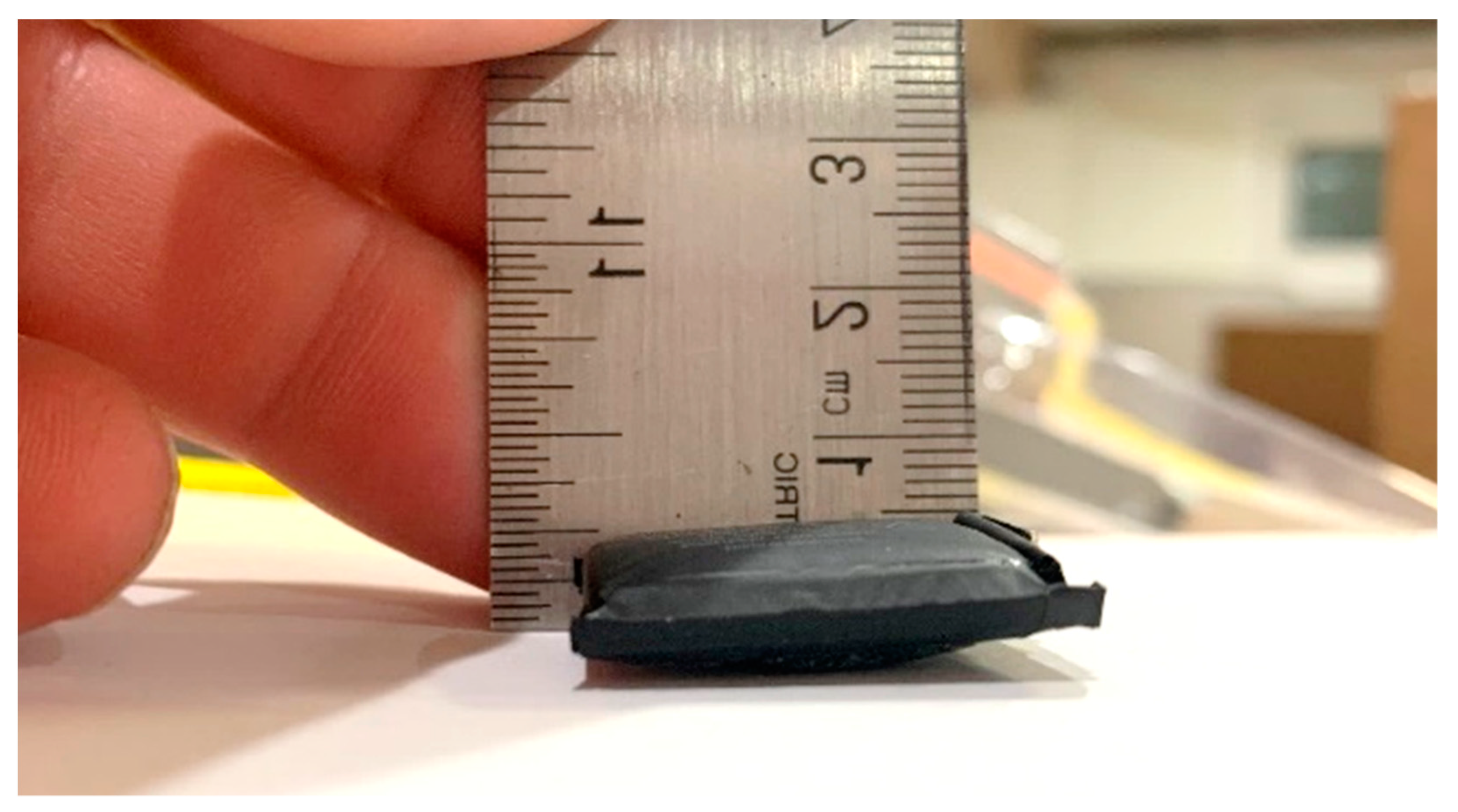
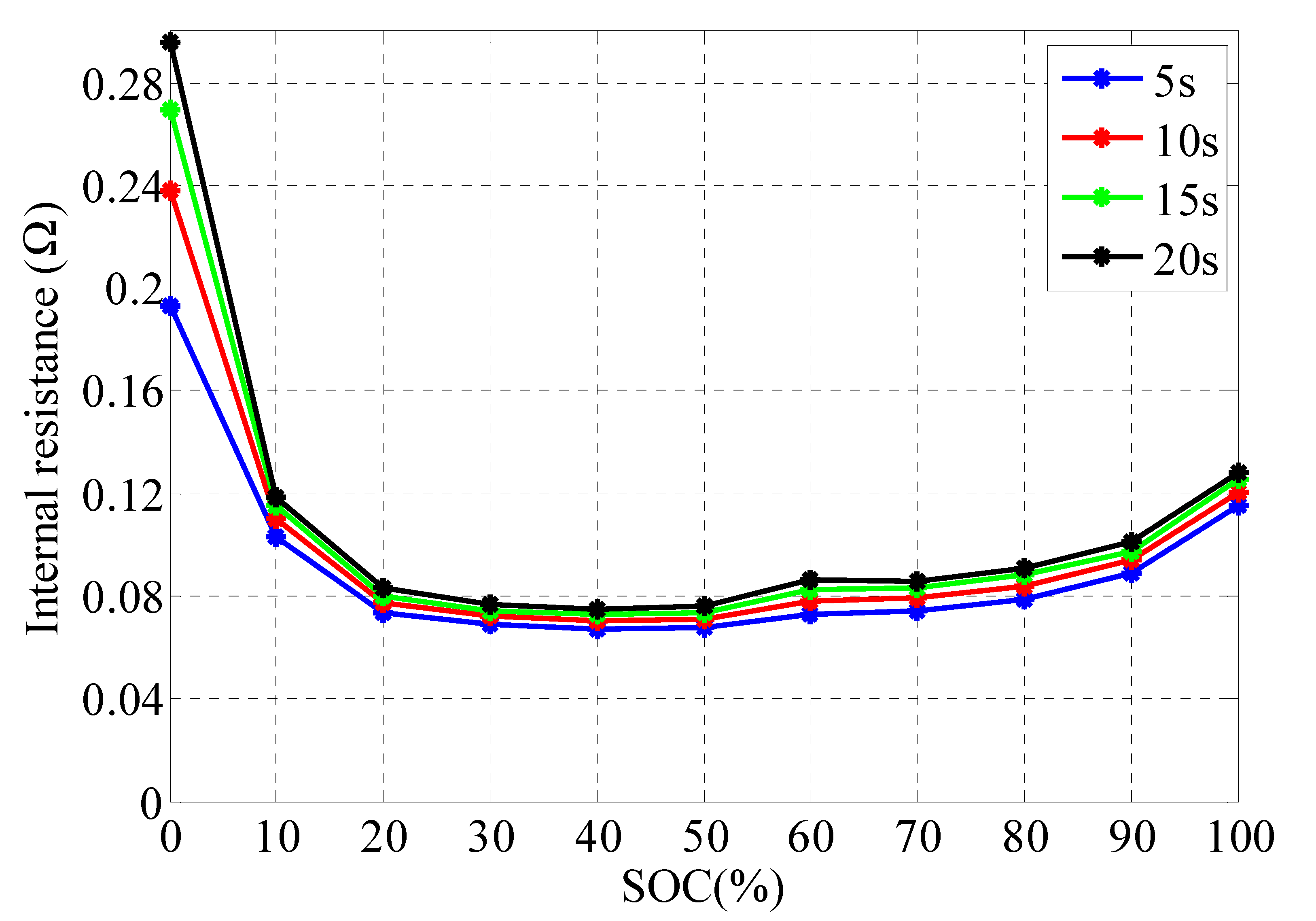
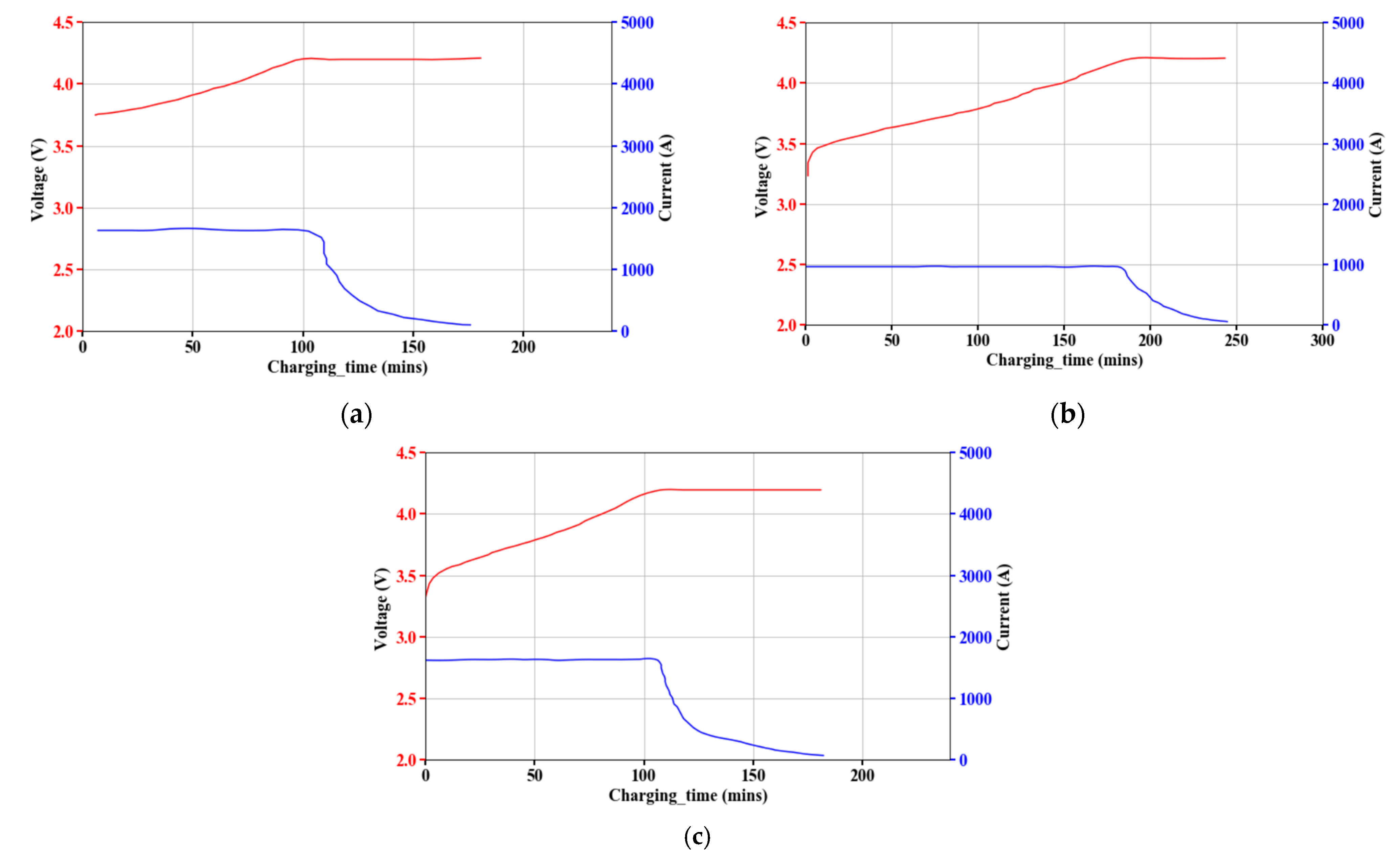
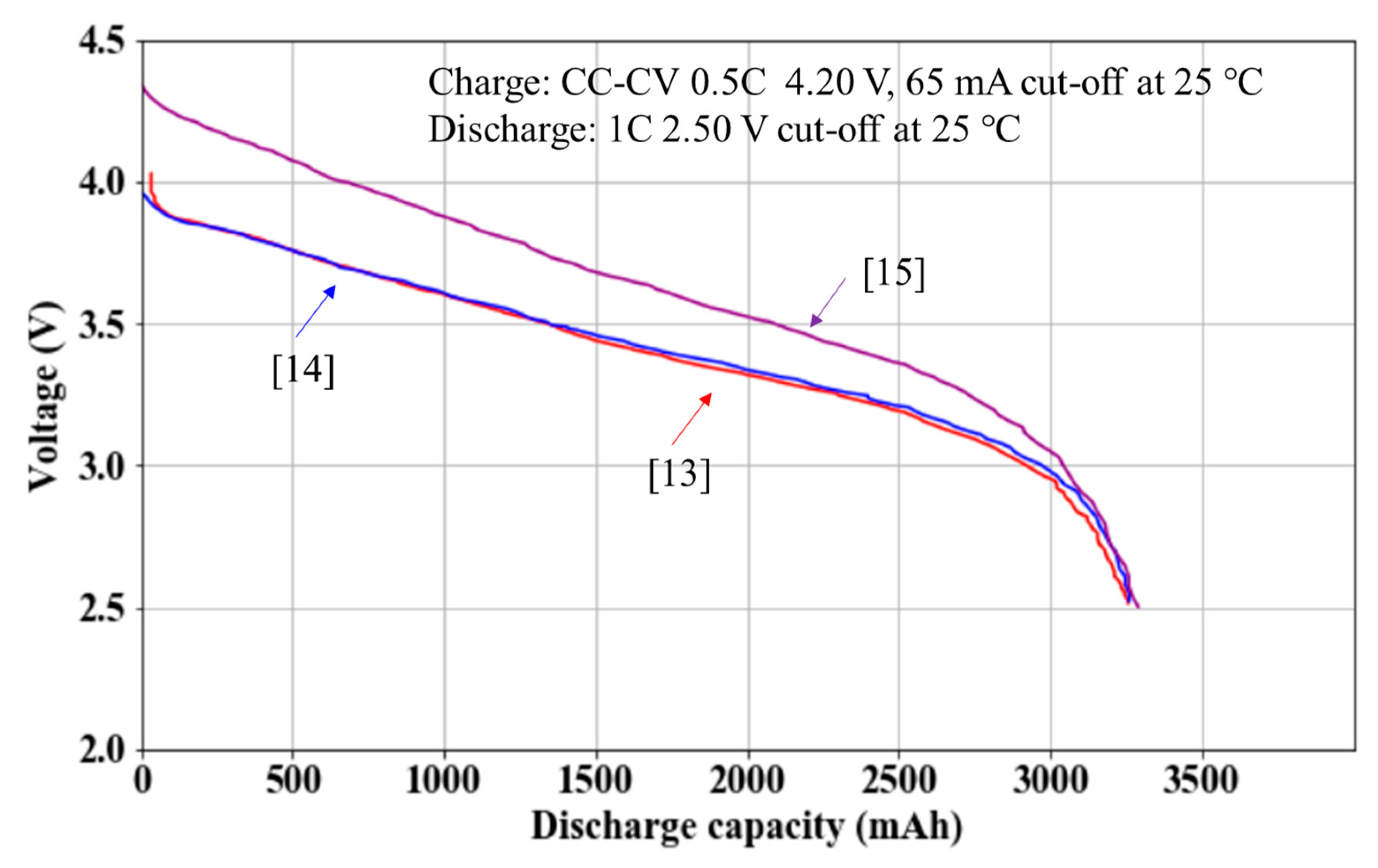
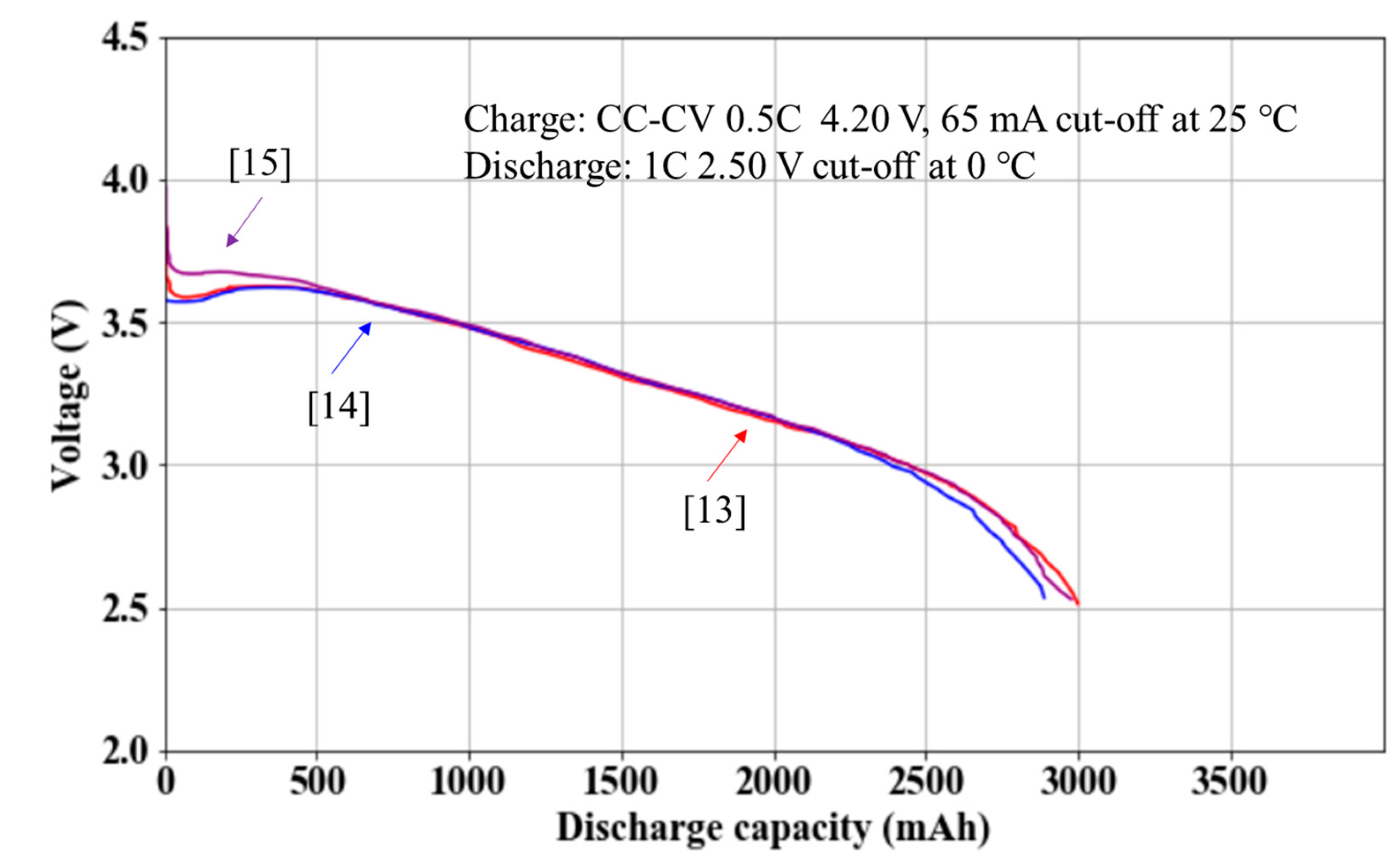
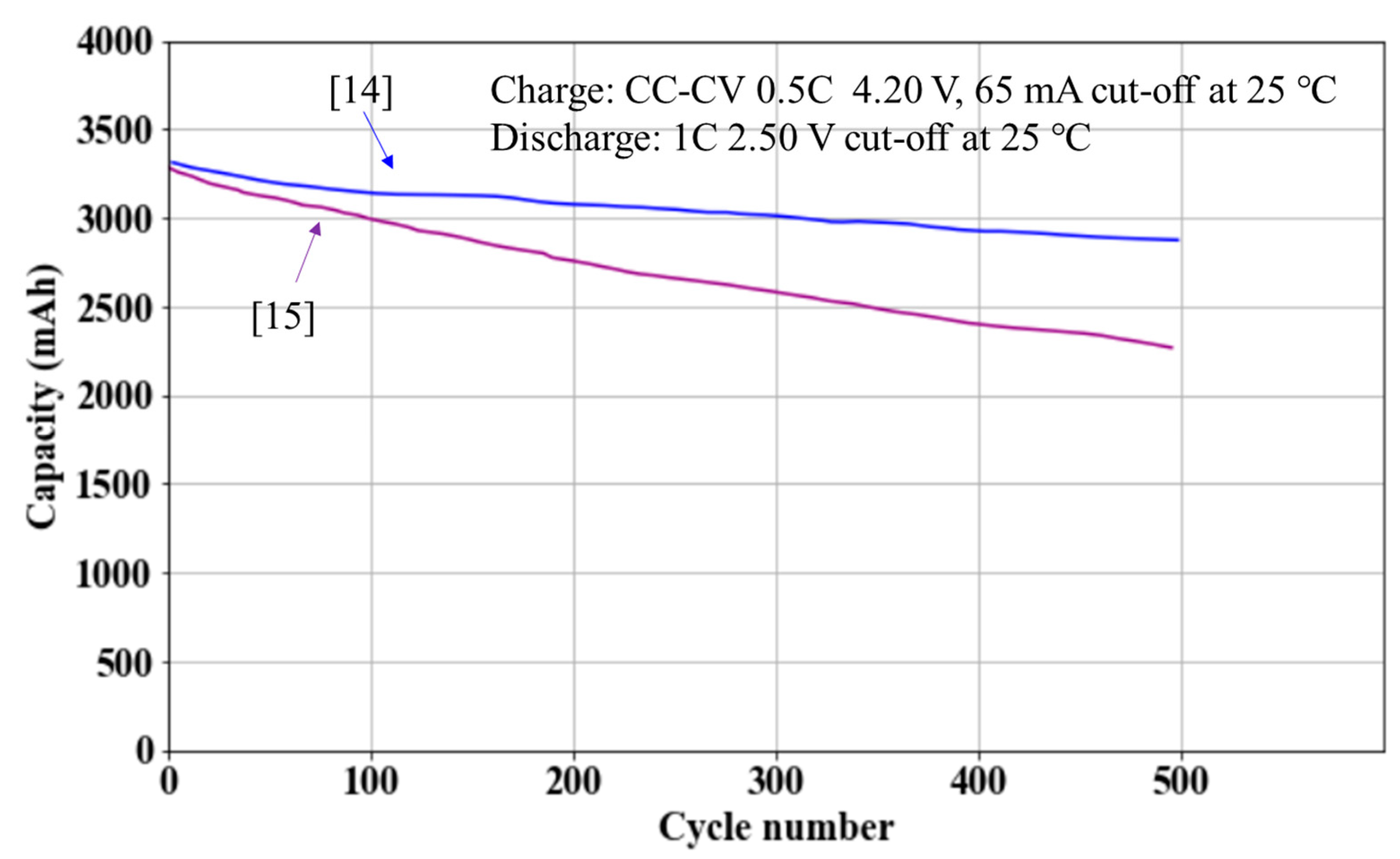
| Manufacturer | Model | Shape | Weight (g) | Diameter (mm) | Height (mm) | Length, Width, Thickness (mm) |
|---|---|---|---|---|---|---|
| Panasonic | NCR18650PF [16] | Cylindrical | Max. 48.0 | Max. 18.5 | Max. 65.3 | — |
| Panasonic | NCR18650B [15] | Cylindrical | Max 48.5 | Max. 18.5 | Max. 65.3 | — |
| Panasonic | NCR18650BD [17] | Cylindrical | Max. 49.5 | Max. 18.25 | Max. 65.10 | — |
| Panasonic | NCR18650BF [18] | Cylindrical | Max. 46.5 | Typ. 18.2 | Typ. 65.0 | — |
| Panasonic | UR18650GA [19] | Cylindrical | Max. 48.0 | Max. 18.50 | Max. 65.30 | — |
| Panasonic | UR18650ZY | Cylindrical | Max. 48.0 | 18.35 ± 0.25 | (64.8 − 0.25)–(64.8 + 0.2) | — |
| Panasonic | UR1865ZM2 | Cylindrical | Max. 46.4 | 18.3 ± 0.2 | (65.1 − 0.25)–(65.1 + 0.2) | — |
| Samsung | ICR18650-26J [20] | Cylindrical | Max. 45.0 | Max. 18.4 | Max. 65.00 | — |
| Samsung | INR21700-50E [21] | Cylindrical | Max. 69 | Max. 20.25 | Max. 70.80 | — |
| Samsung | NR18650-15Q [22] | Cylindrical | Max. 48.0 | 18.15 ± 0.1 | 64.6 ± 0.5 | — |
| LG Chem | 18650HE2 [23] | Cylindrical | Max. 48.0 | (18.3 − 0.3)–(18.3 + 0.2) | 65.0 ± 0.2 | — |
| LG Chem | ICR18650MF1 [24] | Cylindrical | Approx. 44.0 | (18.3 − 0.3)–(18.3 + 0.1) | 65.0 ± 0.2 | — |
| LG Chem | INR18650 B4 [25] | Cylindrical | Approx. Max. 48.0 | 18.29 ± 0.11 | ≤65.05 | — |
| A123 | AMP20m1HD-A [26] | Pouch | 496 | — | — | Length: 227 Width: 160 Thickness: 7.25 |
| A123 | ANR26650m1-B [27] | Cylindrical | 76 | 26 | 65 | — |
| ATL | 902738 [28] | Pouch | — | — | — | Length: Max. 41.3 Width: Max. 27.1 Thickness: fresh max. 9.07; after swelling 9.8 |
| Routejade | SLPB8043128H | Pouch | Max. 84.0 | — | — | Length: Max. 128.0 Width: Max. 43.0 Thickness: Max. 7.8 |
| Routejade | SLPB526495 | Pouch | Max. 63.2 | — | — | Length: Max. 95.5 Width: Max. 64.50 Thickness: Max. 5.20 |
| EEMB | LIR18650 [29] | Cylindrical | 46.5 ± 1 | Max. 18.4 | Max. 65.2 | — |
| EEMB | LIR1632 [30] | Coin | Approx. 1.7 ± 0.3 | (16.0 − 0.2)–16.0 | 3.2–(3.2 + 0.35) | — |
| GMB | GMB043450S [31] | Prismatic | Approx. 14 | — | — | Length: Max. 50.1 Width: Max. 34.0 Thickness: Max. 4.3 |
| VPW | 580013 [32] | Prismatic | 1.288 kg ± 0.02 | — | — | Length: 148 ± 0.15 Width: 101 ± 0.15 Thickness: 39 ± 0.15 |
| VPW | 580049 [33] | Pouch | 0.415 kg ± 0.02 | — | — | Length: 194 Width: 91 Thickness: 11.8 |
| Toshiba | Toshiba-LTO-20AH [34] | Prismatic | 515 g | — | — | Length: 116 Width: 106 Thickness: 22 |
| Johnson Controls-SAFT | MP 174865 xlr | Prismatic | ~121 g | — | — | Width: 48.0 Height: 65.0 Thickness: 19.0 |
| Manufacturer | Model | Rated Capacity (mAh) | Minimum Capacity (mAh) | Typical Capacity (mAh) | Nominal Capacity (mAh) | Standard Capacity (mAh) | 1 C (mA) |
|---|---|---|---|---|---|---|---|
| Panasonic | NCR18650PF | Min. 2700 (20 °C) | 2750 (25 °C) | 2900 (25 °C) | — | — | — |
| Panasonic | NCR18650B [15] | Min. 3200 (20 °C) | 3250 (25 °C) | 3350 (25 °C) | — | — | — |
| Panasonic | NCR18650BD | 2980|2910 (20 °C) | 3030|2935 (25 °C) | 3180|3080 (25 °C) | — | — | — |
| Panasonic | NCR18650BF | Min. 3200 (20 °C) | — | — | Min. 3250 Typ. 3350 (25 °C) | — | — |
| Panasonic | UR18650GA | 3300 (20 °C) | 3350 (25 °C) | 3450 (25 °C) | — | — | — |
| Panasonic | UR18650ZY | 2450 (20 °C) | 2500 (25 °C) | 2600 | — | — | — |
| Panasonic | UR1865ZM2 | — | — | 2550 | 2420 2470 | — | — |
| Samsung | ICR18650-26J | — | — | — | — | Min. 2550 | 2600 |
| Samsung | INR21700-50E | Min. 4753 | — | — | — | Min. 4900 | 4900 |
| Samsung | NR18650-15Q | 1500 | — | — | — | 145 | — |
| LG Chem | 18650HE2 | — | — | — | 2500 | — | — |
| LG Chem | ICR18650MF1 | — | 2050 | — | 2150 | — | 2150 |
| LG Chem | INR18650 B4 | — | 2500 | — | 2600 | — | 2500 |
| A123 | AMP20m1HD-A | — | 19.6 Ah | — | — | — | — |
| A123 | ANR26650m1-B | — | 2.4 Ah | — | 2.5 Ah | — | — |
| ATL | 902738 | — | 90 | 92 | — | — | — |
| Routejade | SLPB8043128H | — | — | — | 3300 | — | 3300 |
| Routejade | SLPB526495 | — | — | — | 3200 | — | 3200 |
| EEMB | LIR18650 | — | 2500 | 2500 | 2600 | — | — |
| EEMB | LIR1632 | 25 ± 5 | — | — | — | — | — |
| GMB | GMB043450S | — | 530 | 550 | — | — | 550 |
| VPW | 580013 | — | — | 75 Ah | — | — | — |
| VPW | 580049 | — | — | 22 Ah | — | — | — |
| Toshiba | Toshiba-LTO-20AH | — | — | — | 20 Ah | — | — |
| Johnson Controls-SAFT | MP 174865 xlr | — | — | 5.3 Ah | — | — | 5.1 A |
| Manufacturer | Model | Charge | Discharge | ||||
|---|---|---|---|---|---|---|---|
| Standard Current/C-Rate | Max. Current/C-Rate | Temperature Range (°C) | Standard Current/C-Rate | Max. Current/C-Rate | Temperature Range (°C) | ||
| Panasonic | NCR18650PF | 1375 mA | — | 0–45 | — | — | −20–60 |
| Panasonic | NCR18650B [15] | 1625 mA | — | 10–45 | — | — | −20–60 |
| Panasonic | NCR18650BD | 0.3 C | — | 10–45 | — | — | −20–60 |
| Panasonic | NCR18650BF | 1625 mA | — | 0–45 | — | — | −20–60 |
| Panasonic | UR18650GA | 1475 mA | — | 10–45 | — | — | −20–60 |
| Panasonic | UR18650ZY | 1.75 A | — | 0–45 | — | Continuous: 5 A | −20–60 |
| Panasonic | UR1865ZM2 | 1.24 A at 10–45 °C; 0.62 A at 0–10 °C | — | 0–45 | — | 10 A | −20–60 |
| Samsung | ICR18650-26J | 1.3 A | — | 0–45 | 520 mA | Continuous: 5.2 A | −10–60 |
| Samsung | INR21700-50E | 2450 mA | 4900 mA | 0–45 | 980 mA | Continuous: 9800 mA; Non-continuous: 14,700 mA | −20–60 |
| Samsung | NR18650-15Q | 750 mA | 4 A at 25 °C | 5–45 | — | 18 A at 25 °C | −20–60 |
| LG Chem | 18650HE2 | 1250 mA | 4000 mA | 0–50 | 500 mA | Continuous: 20,000 mA | −20–75 |
| LG Chem | ICR18650MF1 | 0.5 C | 1 C | 0–45 | 0.2 C | 10 A | −20–60 |
| LG Chem | INR18650 B4 | 0.5 C | 1 C | 0–45 | 0.2 C | −20–5 °C: 0.5 C; 5–45 °C: 2 C; 45–60 °C: 1.5 C | −20–60 |
| A123 | AMP20m1HD-A | — | — | −30–55 | — | — | −30–55 |
| A123 | ANR26650m1-B | 2.5 A | — | −30–55 | — | Continuous: 50 A; 10 s pulse: 120 A | −30–55 |
| ATL | 902738 | — | — | 0–45 | — | 1 C | −10–60 |
| Routejade | SLPB8043128H | 1 C | 2 C | 0–45 | 1 C | Continuous: 20 C; Pulse: 40 C | −10–60 |
| Routejade | SLPB526495 | 1 C | 2 C | 0–45 | 1 C | Continuous: 2 C; Pulse: 3 C | −10–60 |
| EEMB | LIR18650 | 0.52 A | — | 0–45 | 0.52 A | Pulse: 2.6 A | −20–60 |
| EEMB | LIR1632 | 0.5 C | 1 C | −20–45 | — | 2 C | −20–60 |
| GMB | GMB043450S | 0.5 C | Continuous: 1 C | 0–45 | 0.2 C | Continuous: 1.5 C | −20–60 |
| VPW | 580013 | — | — | 10–45 | — | Continuous at 25 °C: 150 A; 60 s Pulse at 25 °C: 300 A | −30–60 |
| VPW | 580049 | — | — | 0–45 | — | Continuous at 25 °C: 330 A; 60 s pulse at 25 °C: 660 A | −20–60 |
| Toshiba | Toshiba-LTO-20AH | — | — | −30–50 | — | — | — |
| Johnson Controls-SAFT | MP 174865 xlr | — | 5 A | −35–60 | C/5 | Continuous: 10 A; Pulses: 21 A | −30–60 |
| Manufacturer | Model | Nominal Voltage (V) | Typical Voltage (V) | Voltage Range (V) |
|---|---|---|---|---|
| Panasonic | NCR18650PF | 3.6 | — | 2.5–4.2 |
| Panasonic | NCR18650B [15] | 3.6 | — | 2.5–4.2 |
| Panasonic | NCR18650BD | 3.6 | — | 2.5–4.2 |
| Panasonic | NCR18650BF | 3.6 | — | 2.5–4.2 |
| Panasonic | UR18650GA | 3.6 | — | 2.5–4.2 |
| Panasonic | UR18650ZY | 3.7 | — | 2.75–4.2 |
| Panasonic | UR1865ZM2 | 3.6 | — | 2.5–4.2 |
| Samsung | ICR18650-26J | 3.63 | — | 2.75–4.2 |
| Samsung | INR21700-50E | 3.6 | — | 2.5–4.2 |
| Samsung | INR18650-15Q | 3.6 | — | 2.5–4.2 |
| LG Chem | 18650HE2 | Average for standard discharge: 3.6 | — | 2.5–4.2 |
| LG Chem | ICR18650MF1 | Average for standard discharge: 3.65 | — | 2.75–4.2 |
| LG Chem | INR18650 B4 | 3.6 | — | 2.75–4.2 |
| A123 | AMP20m1HD-A | 3.3 | — | — |
| A123 | ANR26650m1-B | 3.3 | — | 2–3.6 |
| ATL | 902738 | — | 3.7 | 3–4.2 |
| Routejade | SLPB8043128H | 3.7 | — | 3–4.2 |
| Routejade | SLPB526495 | 3.7 | — | 2.7–4.2, but cycle at 3–4.2 |
| EEMB | LIR18650 | Average value of the working voltage during the whole discharge process: 3.7 | — | 2.75–4.2 |
| EEMB | LIR1632 | 3.6 | — | 2.75–4.2 |
| GMB | GMB043450S | Mean operation voltage during standard discharge after standard charge: 3.7 | — | 2.75–4.2 |
| VPW | 580013 | 3.65 | — | 2.8–4.2 |
| VPW | 580049 | 3.7 | — | 3.0–4.2 |
| Toshiba | Toshiba-LTO-20AH | 2.4 | — | 1.5–2.7 |
| Johnson Controls-SAFT | MP 174865 xlr | 3.65 | — | 2.5–4.2 |
| Manufacturer | Model | Impedance/Resistance |
|---|---|---|
| Panasonic | NCR18650PF | — |
| Panasonic | NCR18650B [15] | — |
| Panasonic | NCR18650BD | — |
| Panasonic | NCR18650BF | — |
| Panasonic | UR18650GA | — |
| Panasonic | UR18650ZY | AC impedance at 1 kHz: <100 mΩ |
| Panasonic | UR1865ZM2 | AC impedance at 1 kHz: <40 mΩ |
| Samsung | ICR18650-26J | AC impedance at 1 kHz: <35 mΩ after standard charge |
| Samsung | INR21700-50E | AC impedance at 1 kHz: <35 mΩ after standard charge |
| Samsung | NR18650-15Q | AC impedance at 1 kHz: <25 mΩ after standard charge |
| LG Chem | 18650HE2 | — |
| LG Chem | ICR18650MF1 | AC impedance at 1 kHz: <35 mΩ after standard charge |
| LG Chem | INR18650 B4 | AC impedance at 1 kHz: <70 mΩ after standard charge |
| A123 | AMP20m1HD-A | — |
| A123 | ANR26650m1-B | — |
| ATL | 902738 | AC impedance at 1 kHz: <300 mΩ at 50% SOC |
| Routejade | SLPB8043128H | AC impedance at 1 kHz: <5 mΩ after standard charge |
| Routejade | SLPB526495 | AC impedance at 1 kHz: <15 mΩ after standard charge |
| EEMB | LIR18650 | AC impedance ≤70 mΩ |
| EEMB | LIR1632 | — |
| GMB | GMB043450S | AC impedance at 1 kHz: ≤70 mΩ |
| VPW | 580013 | DC resistance ≤1.4 mΩ |
| VPW | 580049 | DC resistance ≤2 mΩ |
| Toshiba | Toshiba-LTO-20AH | — |
| Johnson Controls-SAFT | MP 174865 xlr | — |
| Manufacturer | Model | Specific Energy (Wh/kg) | Energy Density (Wh/L) | Specific Power (W/kg) | Power Density (W/L) |
|---|---|---|---|---|---|
| Panasonic | NCR18650PF | 207 | 577 | — | — |
| Panasonic | NCR18650B [15] | 243 | 676 | — | — |
| Panasonic | NCR18650BD | 217|212 | 630|615 | — | — |
| Panasonic | NCR18650BF | 248 | 677 | — | — |
| Panasonic | UR18650GA | 224 | 693 | — | — |
| Panasonic | UR18650ZY | — | — | — | — |
| Panasonic | UR1865ZM2 | — | — | — | — |
| Samsung | ICR18650-26J | — | — | — | — |
| Samsung | INR21700-50E | — | — | — | — |
| Samsung | NR18650-15Q | — | — | — | — |
| LG Chem | 18650HE2 | — | — | — | — |
| LG Chem | ICR18650MF1 | — | — | — | — |
| LG Chem | INR18650 B4 | — | — | — | — |
| A123 | AMP20m1HD-A | 131 | 247 | 2400 | — |
| A123 | ANR26650m1-B | — | — | 2600, @ 23 °C, 50% SOC, 10 s discharge | — |
| ATL | 902738 | — | — | — | — |
| Routejade | SLPB8043128H | — | — | — | — |
| Routejade | SLPB526495 | — | — | — | — |
| EEMB | LIR18650 | — | — | — | — |
| EEMB | LIR1632 | — | — | — | — |
| GMB | GMB043450S | — | — | — | — |
| VPW | 580013 | 213 | — | ≥1368.8 | — |
| VPW | 580049 | 196 | — | ≥5884 | — |
| Toshiba | Toshiba-LTO-20AH | — | 176 | — | — |
| Johnson Controls-SAFT | MP 174865 xlr | 159 | 371 | — | — |
| Manufacturer | Model | Cycle Life |
|---|---|---|
| Panasonic | NCR18650PF | The capacity fade curve for 500 cycles |
| Panasonic | NCR18650B [15] | The capacity fade curve for 500 cycles |
| Panasonic | NCR18650BD | The capacity fade curve for 500 cycles |
| Panasonic | NCR18650BF | The capacity fade curve for 300 cycles |
| Panasonic | UR18650GA | The capacity fade curve for 500 cycles |
| Panasonic | UR18650ZY | Discharge time >38 min. at standard discharge conditions after 300 cycles |
| Panasonic | UR1865ZM2 | The capacity fade curve for 1000 cycles |
| Samsung | ICR18650-26J | ≥1785 mAh (70%) after 300 cycles |
| Samsung | INR21700-50E | ≥3802 mAh (80%) after 500 cycles |
| Samsung | NR18650-15Q | ≥870 mAh (60%) after 250 cycles |
| LG Chem | 18650HE2 | ≥60% after 300 cycles at 10 A discharge or after 200 cycles at 20 A discharge |
| LG Chem | ICR18650MF1 | ≥70% after 500 cycles |
| LG Chem | INR18650 B4 | ≥80% after 300 cycles |
| A123 | AMP20m1HD-A | The capacity fade curve for 3200 cycles |
| A123 | ANR26650m1-B | The capacity fade curves for three conditions up to 1450 cycles |
| ATL | 902738 | — |
| Routejade | SLPB8043128H | ≥2560 mAh after 1000 cycles |
| Routejade | SLPB526495 | ≥2640 mAh after 1000 cycles |
| EEMB | LIR18650 | ≥2050 mAh after 300 cycles |
| EEMB | LIR1632 | ≥80% after 500 cycles |
| GMB | GMB043450S | ≥70% after 500 cycles |
| VPW | 580013 | ≥80% after 2000 cycles at 25 °C, or after 1200 cycles at 45 °C |
| VPW | 580049 | ≥80% after 200 cycles |
| Toshiba | Toshiba-LTO-20AH | The capacity fade curve at 3C, 25 °C up to 15,000 cycles |
| Johnson Controls-SAFT | MP 174865 xlr | The capacity fade curve at C/2, 20 °C up to 950 cycles |
| Manufacturer | Model | Storage Temperature (°C) | Charge Retention | Capacity Retention |
|---|---|---|---|---|
| Panasonic | NCR18650PF | −20–50 | — | — |
| Panasonic | NCR18650B [15] | −20–50 | — | — |
| Panasonic | NCR18650BD | −20–50 | — | — |
| Panasonic | NCR18650BF | −20–50 | — | — |
| Panasonic | UR18650GA | −20–50 | — | — |
| Panasonic | UR18650ZY | −20–50, less than 1 month −20–40, less than 3 months −20–20, less than 1 year | Discharge time > 30 min (25 °C) after 20 days at 60 °C, 100% SOC | Discharge time > 40 min (25 °C) after 20 days at 60 °C, 100% SOC and being fully charged at 25 °C |
| Panasonic | UR1865ZM2 | 20–50, less than 1 month −20–40, less than 3 months −20–20, less than 1 year | — | — |
| Samsung | ICR18650-26J | −20–60, 1 month −20–45, 3 months −20–23, 1 year | Charge ≥ 2040 mAh (80%) after 30 days at 23 °C, 100% SOC | — |
| Samsung | INR21700-50E | −20–60, 1 month −20–45, 3 months −20–23, 1 year | Charge ≥ 2040 mAh (80%) after 30 days at 60 °C, 100% SOC | — |
| Samsung | NR18650-15Q | 45–60, 1 month 20–45, 3 months −20–25, 18 months | — | — |
| LG Chem | 18650HE2 | −20–60, 1 month −20–45, 3 months −20–20, 1 year | Charge ≥ 90% after 1 month at 23 °C, 100% SOC | Capacity ≥ 80% after 1 week at 60 °C, 100% SOC |
| LG Chem | ICR18650MF1 | −20–60, 1 month −20–45, 3 months −20–20, 1 year | Charge ≥ 90% after 30 days at 25 °C, 100% SOC | Capacity ≥ 80% after 1 week at 60 °C, 100% SOC |
| LG Chem | INR18650 B4 | −20–60, 1 month −20–45, 3 months −20–20, 1 year | Charge ≥ 90% after 30 days at 25 °C, 100% SOC | Capacity ≥ 80% after 1 week at 60 °C, 100% SOC |
| A123 | AMP20m1HD-A | −40–60 | — | — |
| A123 | ANR26650m1-B | −40–60 | — | — |
| ATL | 902738 | — | The cell voltage for long-time storage shall be 3.6–3.9 V at 25 ± 3 °C after 3 months | — |
| Routejade | SLPB8043128H | 40–60 for up to 1 week 25–40 for up to 3 months −20–25 for up to 1 year | Charge ≥ 75% after 1 week at 60 °C, 100% SOC | — |
| Routejade | SLPB526495 | 40–60 for up to 1 week 25–40 for up to 3 months −20–25 for up to 1 year | Charge ≥ 75% after 1 week at 60 °C, 100% SOC | — |
| EEMB | LIR18650 | 1 month: −5–35 °C; 6 months: 0–35 °C. | Discharge time ≥4 h after 12 months storage at 40–50% SOC at 25 °C, 65 ± 20% RH | — |
| EEMB | LIR1632 | 1 month: −20–60 °C 3 months: −20–45 °C 12 months: −20–25 °C | Electricity Charge: 80% after 28 days at 20 °C at 100% SOC | Capacity fade over storage time at 20, 40, 60 °C |
| GMB | GMB043450S | Less than 1 year: −20–25 Less than 3 months: −20–40 | — | — |
| VPW | 580013 | — | — | — |
| VPW | 580049 | — | — | — |
| Toshiba | Toshiba-LTO-20AH | — | — | The capacity fade over float storage time at 25, 35 and 45 °C, 2.7 V |
| Johnson Controls-SAFT | MP 174865 xlr | Recommended: 10–30 Allowable: −40–60 | — | — |
| Manufacturer | Model | Environmental | Electrical | Mechanical | |||||||||
|---|---|---|---|---|---|---|---|---|---|---|---|---|---|
| Thermal Shock | Heating | Low Temperature | Low Pressure | Overcharge | External Short-Circuiting | Over-Discharge | Impact | Drop | Vibration | Crush | Nail Penetration | ||
| Panasonic | NCR18650PF | — | — | — | — | — | — | — | — | — | — | — | — |
| Panasonic | NCR18650B [15] | — | — | — | — | — | — | — | — | — | — | — | — |
| Panasonic | NCR18650BD | — | — | — | — | — | — | — | — | — | — | — | — |
| Panasonic | NCR18650BF | — | — | — | — | — | — | — | — | — | — | — | — |
| Panasonic | UR18650GA | — | — | — | — | — | — | — | — | — | — | — | — |
| Panasonic | UR18650ZY | — | — | — | — | — | — | — | — | √ | — | — | — |
| Panasonic | UR1865ZM2 | — | — | — | — | — | — | — | — | — | — | — | — |
| Samsung | ICR18650-26J | — | √ | — | — | √ | √ | √ | — | √ | √ | — | — |
| Samsung | INR21700-50E | — | √ | — | — | √ | √ | √ | — | √ | √ | — | — |
| Samsung | INR18650-15Q | — | √ | — | — | √ | √ | — | √ | √ | — | — | |
| LG Chem | 18650HE2 | √ | √ | — | — | √ | √ | √ | √ | √ | √ | √ | — |
| LG Chem | ICR18650MF1 | √ | √ | — | — | √ | √ | √ | √ | √ | √ | √ | — |
| LG Chem | INR18650 B4 | √ | √ | — | — | √ | √ | √ | √ | √ | √ | √ | — |
| A123 | AMP20m1HD-A | — | √ | — | — | √ | √ | √ | — | — | — | √ | √ |
| A123 | ANR26650m1-B | — | — | — | — | — | — | — | — | — | — | — | — |
| ATL | 902738 | — | — | — | — | — | — | — | — | — | — | — | — |
| Routejade | SLPB8043128H | — | √ | — | — | — | √ | — | √ | — | — | — | — |
| Routejade | SLPB526495 | √ | √ | — | √ | √ | √ | — | — | — | — | — | — |
| EEMB | LIR18650 | √ | — | √ | — | √ | √ | — | √ | √ | √ | — | — |
| EEMB | LIR1632 | — | √ | √ | — | √ | √ | — | √ | √ | — | — | |
| GMB | GMB043450S | — | — | — | — | — | √ | √ | √ | — | — | √ | √ |
| VPW | 580013 | — | — | — | — | — | — | — | — | — | — | — | — |
| VPW | 580049 | — | — | — | — | — | — | — | — | — | — | — | — |
| Toshiba | Toshiba-LTO-20AH | — | — | — | — | — | — | — | — | — | — | — | — |
| Johnson Controls-SAFT | MP 174865 xlr | — | — | — | — | — | — | — | — | — | — | — | — |
Publisher’s Note: MDPI stays neutral with regard to jurisdictional claims in published maps and institutional affiliations. |
© 2021 by the authors. Licensee MDPI, Basel, Switzerland. This article is an open access article distributed under the terms and conditions of the Creative Commons Attribution (CC BY) license (https://creativecommons.org/licenses/by/4.0/).
Share and Cite
Diao, W.; Kulkarni, C.; Pecht, M. Development of an Informative Lithium-Ion Battery Datasheet. Energies 2021, 14, 5434. https://doi.org/10.3390/en14175434
Diao W, Kulkarni C, Pecht M. Development of an Informative Lithium-Ion Battery Datasheet. Energies. 2021; 14(17):5434. https://doi.org/10.3390/en14175434
Chicago/Turabian StyleDiao, Weiping, Chetan Kulkarni, and Michael Pecht. 2021. "Development of an Informative Lithium-Ion Battery Datasheet" Energies 14, no. 17: 5434. https://doi.org/10.3390/en14175434
APA StyleDiao, W., Kulkarni, C., & Pecht, M. (2021). Development of an Informative Lithium-Ion Battery Datasheet. Energies, 14(17), 5434. https://doi.org/10.3390/en14175434






